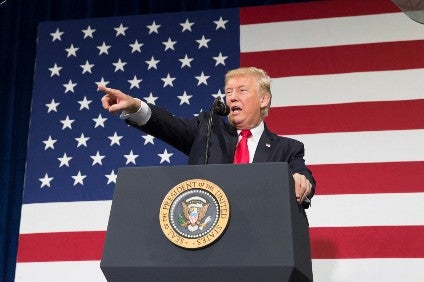
US President Donald Trump has ramped up his trade war with China by announcing that a punitive 10% tariff will be imposed on $300bn worth of US imports from China – including all textiles, apparel and footwear – beginning 1 September.
The move, declared today (1 August) in a tweet, comes after the two sides had just indicated more negotiations on their trade relationship would take place in early September.

Discover B2B Marketing That Performs
Combine business intelligence and editorial excellence to reach engaged professionals across 36 leading media platforms.
…We look forward to continuing our positive dialogue with China on a comprehensive Trade Deal, and feel that the future between our two countries will be a very bright one!
— Donald J. Trump (@realDonaldTrump) August 1, 2019
The extra tariffs will impact virtually all remaining US imports from China not yet hit by punitive tariffs. A draft list released earlier this year shows that around US$36bn worth of textiles, apparel and home textile products imported into the US from China would be affected.

US Tariffs are shifting - will you react or anticipate?
Don’t let policy changes catch you off guard. Stay proactive with real-time data and expert analysis.
By GlobalData“The President’s decision to proceed with adding these additional costs for hard-working American families is truly shocking,” says Rick Helfenbein, president and CEO of the American Apparel & Footwear Association (AAFA).
“This decision will increase the tariff bill on all clothes, shoes, and home textiles, like blankets and sheets – products that already account for the vast majority of the duties collected by the US government.
“The fact that this tweet comes after only one meeting with the Chinese delegation following the resumption of talks is extremely concerning. It is time for Congress to step up and take back its authority to manage international trade as outlined under the US Constitution.”
Trade talks backfire
Indeed, it had seemed that the threat of more tariffs was receding after discussions between the US and China got underway again in Shanghai this week, covering forced technology transfer, intellectual property rights, services, non-tariff barriers, and agriculture, according to a brief statement from the White House.
“The Chinese side confirmed their commitment to increase purchases of United States agricultural exports,” it said, adding: “The meetings were constructive, and we expect negotiations on an enforceable trade deal to continue in Washington, DC, in early September.”
The two days of meetings in Shanghai were the first trade talks since a truce between US President Trump and China’s President Xi Jinping at the G-20 summit in Japan in June.
Following the meeting in Osaka, Trump agreed not to increase tariffs on $300bn worth of Chinese imports while the two sides continued negotiations.
Previous trade talks between the two collapsed in May, prompting a 25% hike in tariffs on US$250bn of goods imported from China.
The impact of the tariff uncertainty is prompting US fashion sourcing executives to move production out of China in response.
A recent survey published by the United States Fashion Industry Association (USFIA) found 83% of respondents expect to decrease sourcing from China over the next two years.
Up to 63% also blame the US tariff action for higher sourcing costs, with the average price of US apparel imports from Bangladesh, Vietnam and India – the main alternatives to China – rising by more than 20% in the first five months of 2019 as more companies move their orders to these countries.
In 2018, 42% of apparel and 69% of footwear sold in the US was imported from China. The punitive tariff would be added on top of the tariffs already imposed on these products – in 2017, 51% of the duties collected by the US government came from the apparel, footwear, textiles, and travel goods industry, despite accounting for only 6% of all imports, the AAFA says.
Most textiles, all travel goods, and many accessories are already being hit with a 25% additional tariff as part of previous steps taken by the administration in the trade conflict with China.
During a public comment period in June, dozens of executives from apparel and footwear brands, retailers and importers shared their concerns over how new China tariffs could hit the US apparel trade. Here’s what they had to say.
For more responses to the looming China tariffs on clothing and footwear, click on the following link: US fashion industry reeling as new China tariffs loom.





